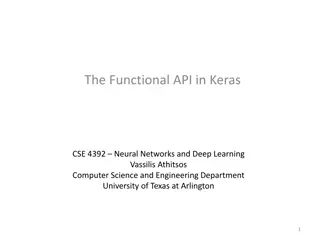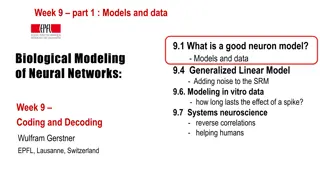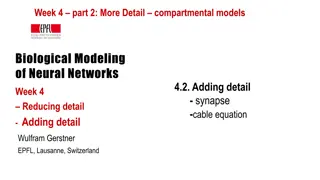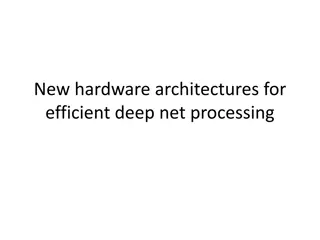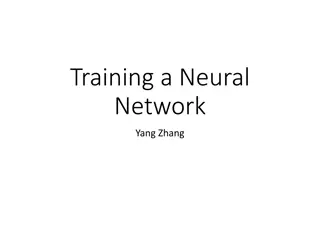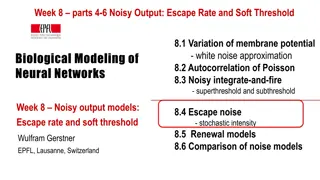Exploring Biological Neural Network Models
Understanding the intricacies of biological neural networks involves modeling neurons and synapses, from the passive membrane to advanced integrate-and-fire models. The quality of these models is crucial in studying the behavior of neural networks.
Download Presentation

Please find below an Image/Link to download the presentation.
The content on the website is provided AS IS for your information and personal use only. It may not be sold, licensed, or shared on other websites without obtaining consent from the author. Download presentation by click this link. If you encounter any issues during the download, it is possible that the publisher has removed the file from their server.
E N D
Presentation Transcript
Biological Modeling of Neural Networks 1.1 Neurons and Synapses: Overview 1.2 The Passive Membrane - Linear circuit - Dirac delta-function 1.3 Leaky Integrate-and-Fire Model 1.4 Generalized Integrate-and-Fire Model 1.5. Quality of Integrate-and-Fire Models Neuronal Dynamics: Computational Neuroscience of Single Neurons Week 1 neurons and mathematics: a first simple neuron model Wulfram Gerstner EPFL, Lausanne, Switzerland
Biological Modeling of Neural Networks 1.1 Neurons and Synapses: Overview 1.2 The Passive Membrane - Linear circuit - Dirac delta-function 1.3 Leaky Integrate-and-Fire Model 1.4 Generalized Integrate-and-Fire Model 1.5. Quality of Integrate-and-Fire Models
Neuronal Dynamics 1.1. Neurons and Synapses/Overview motor cortex frontal cortex How do we recognize? Models of cogntion Weeks 10-14 visual cortex to motor output
Neuronal Dynamics 1.1. Neurons and Synapses/Overview motor cortex 10 000 neurons 3 km wire 1mm frontal cortex to motor output
Neuronal Dynamics 1.1. Neurons and Synapses/Overview Signal: action potential (spike) 10 000 neurons 3 km wire 1mm action potential Ramon y Cajal
Neuronal Dynamics 1.1. Neurons and Synapses/Overview Hodgkin-Huxley type models: Biophysics, molecules, ions (week 2) Signal: action potential (spike) -70mV Na+ action potential K+ Ca2+ Ions/proteins
Neuronal Dynamics 1.1. Neurons and Synapses/Overview Signal: action potential (spike) action potential
Neuronal Dynamics 1.1. Neurons and Synapses/Overview Integrate-and-fire models: Formal/phenomenological (week 1 and week 6+7) Spike emission u Spike reception t synapse -spikes are events -triggered at threshold -spike/reset/refractoriness Postsynaptic potential
Noise and variability in integrate-and-fire models Spike emission j i i u Output -spikes are rare events -triggered at threshold Subthreshold regime: -trajectory of potential shows fluctuations Random spike arrival
Neuronal Dynamics membrane potential fluctuations Spontaneous activity in vivo What is noise? What is the neural code? (week 8+9) electrode Brain awake mouse, cortex, freely whisking, Crochet et al., 2011
Neuronal Dynamics Quiz 1.1 A cortical neuron sends out signals which are called: [ ] action potentials [ ] spikes [ ] postsynaptic potential The dendrite is a part of the neuron [ ] where synapses are located [ ] which collects signals from other neurons [ ] along which spikes are sent to other neurons In an integrate-and-fire model, when the voltage hits the threshold: [ ] the neuron fires a spike [ ] the neuron can enter a state of refractoriness [ ] the voltage is reset [ ] the neuron explodes In vivo, a typical cortical neuron exhibits [ ] rare output spikes [ ] regular firing activity [ ] a fluctuating membrane potential Multiple answers possible!
Neural Networks and Biological Modeling 1.1. Overview Week 1: A first simple neuron model/ neurons and mathematics Week 2: Hodgkin-Huxley models and biophysical modeling Week 3: Two-dimensional models and phase plane analysis Week 4: Two-dimensional models Dendrites Week 5,6,7: Associative Memory, Learning, Hebb, Hopfield action potential Week 8,9: Noise models, noisy neurons and coding Week 10: Estimating neuron models for coding and decoding Week 11-14: Networks and cognitions
Neural Networks and Biological modeling Course: Monday : 9:15-13:00 have your laptop with you A typical Monday: 1st lecture 9:15-9:50 1st exercise 9:50-10:00 2nd lecture 10:15-10:35 2nd exercise 10:35-11:00 3rd lecture 11:15 11:40 3rd exercise 12:15-13:00 Course of 4 credits = 6 hours of work per week 4 contact + 2 homework paper and pencil paper and pencil paper and pencil OR interactive toy examples on computer moodle.eplf.ch http://lcn.epfl.ch/
Neural Networks and Biological Modeling Questions?
Week 1 part 2: The Passive Membrane 1.1 Neurons and Synapses: Overview 1.2 The Passive Membrane - Linear circuit - Dirac delta-function 1.3 Leaky Integrate-and-Fire Model 1.4 Generalized Integrate-and-Fire Model 1.5. Quality of Integrate-and-Fire Models Neuronal Dynamics: Computational Neuroscience of Single Neurons Week 1 neurons and mathematics: a first simple neuron model Wulfram Gerstner EPFL, Lausanne, Switzerland
Neuronal Dynamics 1.2. The passive membrane electrode Spike emission u t synapse potential Integrate-and-fire model
Neuronal Dynamics 1.2. The passive membrane j i i u Spike reception I Subthreshold regime - linear - passive membrane - RC circuit
Neuronal Dynamics 1.2. The passive membrane I(t) Time-dependent input i u I(t) Math development: Derive equation u
Passive Membrane Model I(t) u
Passive Membrane Model j i i u I Math Development: Voltage rescaling d = rest+ ( ) ( ) u u u RI t dt d = + = ( ); ( ) V V RI t V u u rest dt
Passive Membrane Model d = rest + ( ) ( ) u u u RI t dt dV dt = + = ( ); ( ) V RI t V u u rest
Passive Membrane Model/Linear differential equation dV V RI t dt = + ( ); Free solution: exponential decay
Neuronal Dynamics Exercises NOW Start Exerc. at 9:47. Next lecture at 10:15 1( ) I t ( ) u t ( ) I t Step current input: 2( ) I t Pulse current input: 3( ) I t arbitrary current input: d = rest+ ( ) ( ) u u u RI t Calculate the voltage, for the 3 input currents dt d = + = ( ); ( ) V V RI t V u u rest dt
Passive Membrane Model exercise 1 now Step current input: i i u I(t) TA s: Carlos Stein Hesam Setareh Samuel Muscinelli Alex Seeholzer impulse reception: impulse response function Start Exerc. at 9:47. Next lecture at 10:15 Linear equation d = rest + ( ) ( ) u u u RI t dt
Triangle: neuron electricity - math i ( ) I t u I(t) d u = rest+ ( ) ( ) u u u RI t dt
Pulse input charge delta-function ( ) u t ( ) I t u d = rest+ ( ) ( ) u u u RI t ( ) I t dt = t t ( ) I t ( ) q Pulse current input 0
Dirac delta-function = t t ( ) I t ( ) q 0 ( ) I t t ( ) I t u + t a 0 = t t dt 1 ( ) 0 d = rest+ ( ) ( ) u u u RI t t a dt 0 + t a 0 = t t dt ( ) f t ( ) ( f t ) 0 0 t a 0
Neuronal Dynamics Solution of Ex. 1arbitrary input d = rest+ ( ) ( ) u u u RI t dt Arbitrary input t 1 c + = ( )/ t t ( ) ( ') I t dt ' u t u e rest Single pulse q c = ( )/ t t ( ) u t e 0 you need to know the solutions of linear differential equations!
Passive membrane, linear differential equation ( ) I t u d = rest+ ( ) ( ) u u u RI t dt
Passive membrane, linear differential equation If you have difficulties, watch lecture 1.2detour. ( ) I t u d = rest+ ( ) ( ) u u u RI t Three prerequisits: -Analysis 1-3 -Probability/Statistics -Differential Equations or Physics 1-3 or Electrical Circuits dt
Week 1 part 3: Leaky Integrate-and-Fire Model 1.1 Neurons and Synapses: Overview 1.2 The Passive Membrane - Linear circuit - Dirac delta-function - Detour: solution of 1-dim linear differential equation 1.3 Leaky Integrate-and-Fire Model 1.4 Generalized Integrate-and-Fire Model 1.5. Quality of Integrate-and-Fire Models Neuronal Dynamics: Computational Neuroscience of Single Neurons Week 1 neurons and mathematics: a first simple neuron model Wulfram Gerstner EPFL, Lausanne, Switzerland
Neuronal Dynamics 1.3 Leaky Integrate-and-Fire Model d = rest+ ( ) ( ) u u u RI t dt ( ) I t u d u = rest+ ( ) ( ) u u u RI t dt
Neuronal Dynamics Integrate-and-Fire type Models Spike emission u u Input spike causes an EPSP = excitatory postsynaptic potential Simple Integate-and-Fire Model: passive membrane + threshold Leaky Integrate-and-Fire Model -output spikes are events -generated at threshold -after spike: reset/refractoriness
Neuronal Dynamics 1.3 Leaky Integrate-and-Fire Model Spike emission j i u reset I d = rest+ ( ) ( ) u u u RI t linear dt ( ) u t = Fire+reset u u threshold r
Neuronal Dynamics 1.3 Leaky Integrate-and-Fire Model I(t) Time-dependent input i u Math development: Response to step current I(t) -spikes are events -triggered at threshold -spike/reset/refractoriness
Neuronal Dynamics 1.3 Leaky Integrate-and-Fire Model I(t) CONSTANT input/step input i u I(t) I(t)
Leaky Integrate-and-Fire Model (LIF) LIF = d ( ) = rest+ u u ( ) u u u RI u t If 0 r dt Firing Repetitive, current I0 u T t frequency-current relation 1/T Repetitive, current I1> I0 u t I
Neuronal Dynamics First week, Exercise 2 d = rest+ ( ) ( ) u u u RI t dt frequency-current relation 1/T I
EXERCISE 2 NOW: Leaky Integrate-and-fire Model (LIF) d u u = rest+ LIF ( ) If firing: u u u RI 0 r dt Exercise! Calculate the interspike interval T for constant input I. Firing rate is f=1/T. Write f as a function of I. What is the frequency-current curve f=g(I) of the LIF? repetitive u t Start Exerc. at 10:55. Next lecture at 11:15
Week 1 part 4: Generalized Integrate-and-Fire Model 1.1 Neurons and Synapses: Overview 1.2 The Passive Membrane - Linear circuit - Dirac delta-function 1.3 Leaky Integrate-and-Fire Model 1.4 Generalized Integrate-and-Fire Model 1.5. Quality of Integrate-and-Fire Models Neuronal Dynamics: Computational Neuroscience of Single Neurons Week 1 neurons and mathematics: a first simple neuron model Wulfram Gerstner EPFL, Lausanne, Switzerland
Neuronal Dynamics 1.4. Generalized Integrate-and Fire Spike emission reset Integrate-and-fire model LIF: linear + threshold
Neuronal Dynamics 1.4. Leaky Integrate-and Fire revisited I=0 d u I>0 d dt u LIF dt d = rest+ ( ) ( ) u u u RI t dt If firing: u u u repetitive resting r u u t t
Neuronal Dynamics 1.4. Nonlinear Integrate-and Fire LIF d = rest+ ( ) ( ) u u u RI t dt NLIF d = + ( ) ( ) u F u RI t dt If firing: u u reset
Neuronal Dynamics 1.4. Nonlinear Integrate-and Fire Nonlinear Integrate-and-Fire d I=0 d I>0 u u dt dt NLIF d = + ( ) ( ) u F ( ) t u u RI t u dt u = firing: u u r
Nonlinear Integrate-and-fire Model Spike emission j i i u r F reset I d = + ( ) ( ) u F u RI t NONlinear dt ( ) u t = Fire+reset threshold r
Nonlinear Integrate-and-fire Model I>0 I=0 d d u u dt dt u u r r d Quadratic I&F: ( ) c = = + ( ) ( ) u F u RI t NONlinear 2 + ( ) F u u c c dt u t 2 1 0 ( ) = Fire+reset threshold r
Nonlinear Integrate-and-fire Model I>0 I=0 d d u u dt dt u u r r d Quadratic I&F: ( ) c = = + ( ) ( ) u F u RI t 2 + ( ) F u u c c dt u t 2 1 0 exponential I&F: ( ) = Fire+reset = + ( ) ( ) exp( ) F u u u c u r 0 rest
Nonlinear Integrate-and-fire Model I=0 d u dt u r exponential I&F: ( ) + c d d dt = = F ) rest + + u ( ) NONlinear ) ( t RI u u ( u ( ) u RI t = ( ) u F u u u rest dt u t exp( ) 0 ( ) = Fire+reset threshold r
Nonlinear Integrate-and-fire Model Where is the firing threshold? I>0 I=0 d d u u dt dt u u resting r r u t t d = + ( ) ( ) u F u RI t dt
Week 1 part 5: How good are Integrate-and-Fire Model? 1.1 Neurons and Synapses: Overview 1.2 The Passive Membrane - Linear circuit - Dirac delta-function 1.3 Leaky Integrate-and-Fire Model 1.4 Generalized Integrate-and-Fire Model - where is the firing threshold? 1.5. Quality of Integrate-and-Fire Models - Neuron models and experiments Neuronal Dynamics: Computational Neuroscience of Single Neurons Week 1 neurons and mathematics: a first simple neuron model Wulfram Gerstner EPFL, Lausanne, Switzerland




